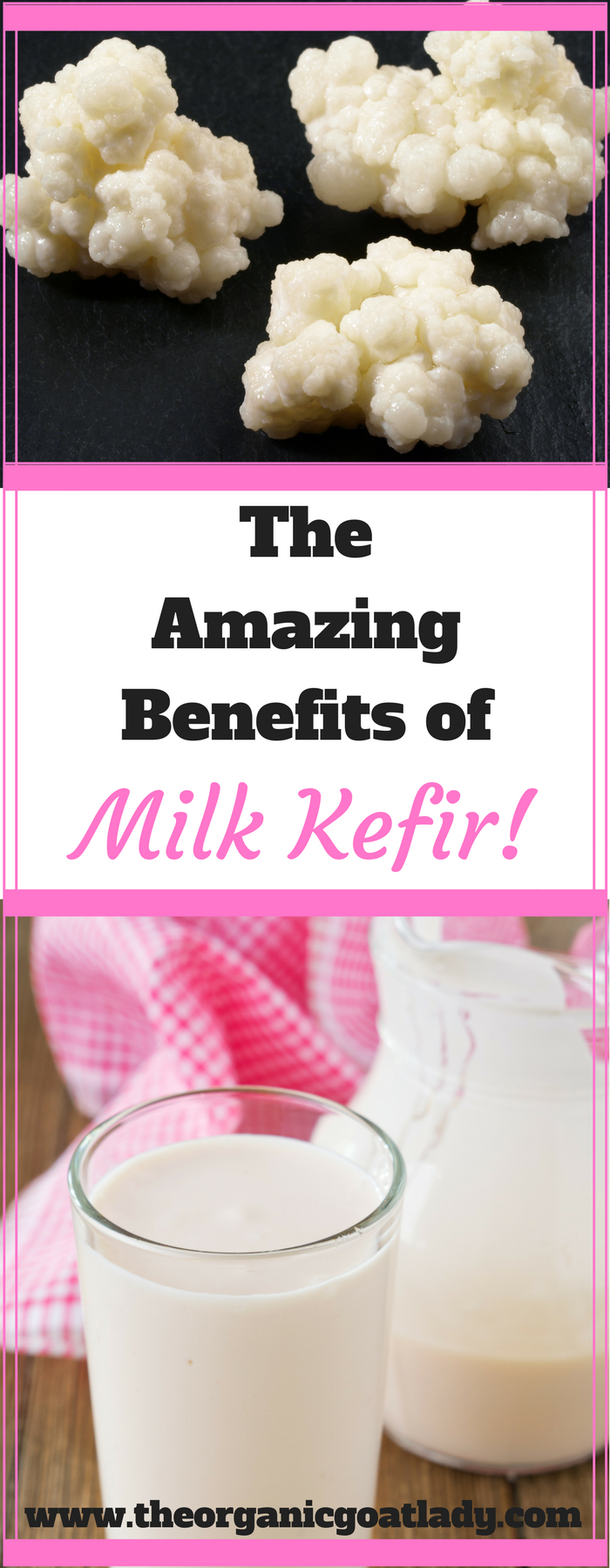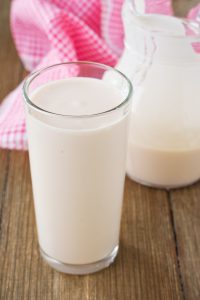Are you looking for an easy way to get your daily dose of probiotics? Are you looking for something easier than eating sauerkraut everyday or are you trying to find a kid friendly option? Then incorporate the amazing benefits of milk kefir into your diet!
This site contains affiliate links. If you make a purchase using one of these links, I may earn a commission. Please click here for more information about cookies collected and our privacy policy.
The Amazing Benefits of Milk Kefir!
If you are anything like me (a research fanatic;) then you have spent many hours researching probiotics and the role that they play in our overall body health!
You also have probably learned about how much more beneficial probiotics are from foods rather than probiotic supplements that you can buy from a store.
If you answered yes to any of the above questions, or if you too are a research fanatic, then you are in the right place!
This is an easy way to make and consume live probiotics!
Probiotic Drinks
We love fermented beverages in my house!
My kids love Kombucha (particularly Orange Ginger Kombucha and Mango Kombucha) and they crave Water Kefir!
And since I am the Organic Goat Lady, I thought that I should try my hand at Milk Kefir!
Cultured Milk
What a great way to use our fresh goat milk!
We LOVE it!
What is Kefir Milk?
There are a lot of similarities between Kombucha and Kefir.
Fermented Drinks
Just like Kombucha, Kefir is a fermented drink that you can make at home.
Though Milk Kefir is traditionally made with cow’s milk, it can also be made with other types of milk (goat, sheep, coconut, almond or rice).
As I discuss in my post The Probiotic Beverage That Your Kids Will Love, Water Kefir, which is made from different “grains” than the Milk Kefir, is made using water and sugar.
Additionally, since Kefir is a fermented drink, once the culture has been established, it can be reused to create multiple batches.
Unlike Kombucha, the Kefir fermentation process is a lot faster; often only taking a day or two instead of a week or two.
Although Water Kefir and Milk Kefir are 2 distinct ferments, they both come chock full of healthy nutrients and probiotics!
Fermented Milk
You can read more about the Amazing history of Milk Kefir here:
Free Milk Kefir Recipe and Brewing Tips + How to Make Coconut Milk Kefir
Milk Kefir Grains
The “grains” that are used to create Kefir are not actual grains but are actually a polysaccharide matrix containing a symbiotic culture of bacteria and yeast (just like a Kombucha SCOBY).
Unlike Kombucha SCOBYs, however, the Kefir grains are more delicate and susceptible to changes in temperature.
They can even starve if they run out of “fuel”.
The Kefir grains used to make Milk Kefir thrive by consuming lactose (milk sugar).
Where as, sucrose (aka table sugar) acts as the fuel for the organisms used to ferment Water Kefir.
Which is one of the things that I love the most about Milk Kefir!
It is SO EASY TO MAKE!
As a busy mom, I love that I can provide such a wide array of beneficial bacteria for my children using literally just a few minutes of my time!
While Water Kefir is also easy to make, it does require the extra step of mixing in and dissolving the sugar.
Milk Kefir is as simple as it gets!
Fermented Dairy
What does Milk Kefir taste like?
I love Hannah Crum’s description of Milk Kefir!
She says that, as with all fermented foods, it has a pleasant tang.
Many say it has a cheesy or yogurty flavor but neither of these totally captures the dynamic, lightly effervescent savoriness of kefir.
So much of the flavor depends on how your milk kefir recipe matches with the brewing environment, the type of milk used and so much more.
Also called the champagne of milk, it has a myriad of uses beyond just a morning smoothie.
It can also serve as a good substitute for buttermilk.
You can also strain the protein-rich whey (like whey powder, except in living liquid form!) from the kefir cheese to make sour cream, yogurt and cream cheese.
While some prefer to drink it plain, we prefer it mixed into smoothies.
Our current favorite is Mango Kefir Smoothies! It is delicious, you have got to try it!
Where can I get Milk Kefir Grains?
The BEST place to buy your Milk Kefir Grains is Kombucha Kamp!
Their Kefir grains are perfect for brewing your own home-made Kefir!
This is because, just like with Kombucha SCOBYs, you need to make sure that they come from a trustworthy source.
If you buy Kefir grains online, it is very important to get them from a reputable source.
Kombucha Kamp’s Water Kefir Grains and Milk Kefir Grains come packaged fresh, fully hydrated (NEVER DEHYDRATED!) and shipped right away via First Class Mail to ensure the most potent Kefir Grains arrive at your door.
While it may take a few batches to reproduce as the grains adapt to their new environment and food source, these hydrated kefir grains will make delicious Kefir and reproduce more quickly than dehydrated Kefir grains.
How To Make Kefir Milk
Like I mentioned above, Milk Kefir is sooo easy to make!
Trust me, this is the easiest Probiotic Beverage you will ever make!
All you need is:
A glass quart jar and plastic lid
1 Tablespoons of Milk Kefir Grains
2 Cups of Whole Milk
Instructions:
Add two cups of milk to your clean glass jar.
Next add your Tablespoon of Kefir Grains.
Cover with the plastic lid and leave in a darkened place out of direct sunlight for 12-48 hours.
I leave mine in a kitchen cabinet.
The Kefir grains prefer a temp. of 65-75 degrees. The warmer your kitchen is the faster the grains will ferment the milk.
After your Kefir has reached the desired flavor and consistency, strain it using a mesh strainer or cheesecloth.
Refrigerate your Kefir and add the Kefir Grains to your next batch of milk to begin again!
And that’s it!
I told you it was easy!
If you are looking for a yummy smoothie recipe that your kids will love, then try my Mango Kefir Smoothie!
My kids love it and I know yours will too!
What kind of milk can I use?
Goat Milk Kefir
Although pasteurized milk is recommended to keep your culture strong, I use raw goat milk from our own dairy goats.
Raw Goat Milk Kefir
So far my grains are growing very well and seem to be thriving in the raw goat milk!
If you feel like your Kefir Grains begin to suffer in raw milk, then you can let them sit in pasteurized milk every few batches to regain their strength.
It might take your Kefir Grains a few batches to adjust to raw milk.
The reason for this is because the bacteria in the grains and the bacteria in the raw milk will compete with each other before they totally adapt.
You can also use Kefir Grains to ferment non-dairy “milks” such as Almond Milk and Coconut Milk.
But you will probably need to refresh the Grains every few batches in Cow or Goat Milk to provide them with the lactose (milk sugar) that they need to survive.
Have you made Milk Kefir before?
What is your favorite way to enjoy this amazing probiotic beverage?
If you haven’t, then give it a try!
I know you will love it!







I’m trying to add fruit to my milk kefir but it keeps separating. Any tips?
Are you blending it together with a blender? A blender will help it to stay together better than mixing by hand. But it might just be something that needs to be blended just before drinking to keep it from separating.